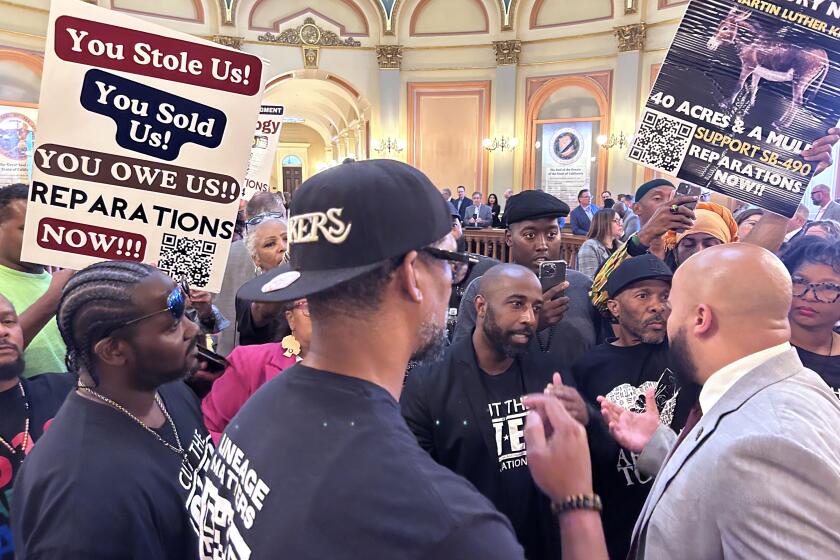4-H Takes to the Streets : The rural group reaches out to urban kids: ‘Before, we used to do drugs, drink alcohol, ditch school,’ one 14-year-old says. ‘Now we come (to the club).’
- Share via
Cows might be out of place in East L.A. And hogs and chickens might not belong downtown.
But 4-H has found its niche--minus the goats and pigs--on the streets of Los Angeles.
The 78-year-old organization, known for teaching kids in rural America a sense of responsibility through breeding animals and harvesting vegetables, has turned its focus toward urban kids.
And in Los Angeles, 4-H is taking its message to children who live in public housing projects. In 1985, there were 4-H programs in three projects; now there are nine.
“We started looking at the housing projects as a microcosm of the community, instead of looking at the whole inner city of Los Angeles,” says John Pusey, a coordinator with 4-H in Los Angeles for 6 1/2 years. “It gave us an identifiable community to work with.”
Though there are some gardening and nature projects, programs are more oriented toward city life. Kids get help with their homework, learn computers and money management and receive career counseling and nutrition training. And children who would normally be on the streets now have a place to go and people to turn to.
“People think of 4-H as cows and cookin’,” says Judy Kingston, 4-H adviser and coordinator. “Instead we have something that is accessible to kids who don’t have a lot of property.”
Says 14-year-old Diana Rascon, a member of 4-H for two years at the Pueblo del Rio housing project in southeast Los Angeles: “Before, we used to do drugs, drink alcohol, ditch school a lot. We were taking stuff, fighting, getting suspended, throwing rocks through windows. We had nothing to do. Now we come to 4-H.”
Many of the young people in today’s 4-H have problems the founders never envisioned: kids with alcoholic parents; kids with brain damage caused by mothers who took drugs when pregnant; even suicide, malnutrition and gang violence.
“We’re different from the traditional 4-H,” Pusey says. “There are more obvious problems here. The kids come from poverty and their resources are extremely limited in terms of access to health care, counseling and opportunities to do things kids normally get to do. The basic stuff of childhood is not available to them. Kids are kids everywhere, these kids just come from a background that is more intense sometimes.”
But 4-H--which stands for head, heart, hands and health--clearly has an impact on their lives, Pusey says. Testing of participants in a summer program showed an increase in self-esteem, and staff regularly observe that fighting diminishes and relationships improve, grades improve, attention spans increase.
“Kids who were getting Ds and Fs are now getting Bs and Cs,” says Rachel Kahn, coordinator at the Dana Strand housing project in San Pedro. “Some of the kids who were getting into gangs jumped out, and they’re now with us. We work with the younger kids--10, 11, 12--and try to get those kids who are hanging on the fence and can jump either way.”
Though 4-H has changed since it was established in 1914--as part of the federal Smith-Lever Act to assist farmers and their families--it has maintained its emphasis on “clear thinking, sensitivity, helpfulness and vitality,” as well as its “learn through doing” mentality.
“We don’t fish for (kids), we teach them how to fish,” says Los Angeles County 4-H development coordinator Ray Grabinski, a Long Beach City councilman and the county Transportation Commission chairman. “Through accomplishment and achievement we allow them to grow. That gives them a certain self-confidence.”
Says 10-year-old Edwin Kearney, who wants to be a doctor when he grows up: “I try not to fight now. I haven’t gotten in trouble this whole (school year), since I started 4-H.”
For many of the African-American, Latino and Cambodian-American children who make up the club at the Pueblo del Rio housing project, 4-H has become a surrogate home.
“They talk to you about grown-up things. If I have problems, they help and I can talk to them,” says 12-year-old Ieasha Howard, a two-year member of 4-H who says she wants to be an actress.
Though 4-H tries to adequately serve the needs of its kids, many of the problems the volunteers and staff members face call for more training than most have.
“We’d love to get a professional counselor in on a weekly or even every other week basis,” Kahn says. “There is abuse and kids come in and talk about it. We have to report it. We deal with a lot (more) than we’re trained for.”
The Los Angeles County 4-H budget is about $1 million. Less than $50,000 of that comes from the county--the rest comes from outside resources, including grants and corporate donations. Unocal recently gave a $25,000 grant to 4-H in the Estrada Court Housing Project.
Benny Harris, who runs the program at Pueblo del Rio, says that because of budget cuts, supplies and resources are now limited.
“We started with a large budget, now we barely have enough to survive,” Harris says. “The kids need (this program) bad.”
Harris began 4-H in that area more than two years ago by going door to door, talking to parents, leaving flyers. At first, he said, he was “cussed out.” But gradually people began to trust him. Now the program serves up to 114 children.
“At first I couldn’t even walk around here, because I was a new face and no one would speak to me,” he said. “Now even the gang members say, ‘What’s up, Mr. Harris?’ when they see me.”
Activities at Pueblo del Rio include games, field trips to the zoo and Sea World, arts and crafts and computer training. But the first priority is always homework.
“The kids want to better themselves,” says Harris, whose job also often includes teaching English to the Cambodian-American children. “After they’re here a while they open up, and their whole attitude changes.”
The Pueblo del Rio 4-H is run by Harris, two other staff members and Aquanetta Thompson, a parent who has volunteered daily for more than a year.
“This keeps them involved in things other than the bad stuff,” says Thompson, 26. “You walk down the street and there is a drug transaction on every corner. Here it’s safe.”
Thompson, who has two daughters, 9 and 4, and a 4-year-old foster son, recently began what she calls “Girl Talk.” It’s a time for the girls in the neighborhood to come and gossip, talk about what’s going on in their lives and to ask questions.”
The motto at Girl Talk meetings, held twice weekly, is “stay up and be positive.” Thompson teaches the girls, who range in age from 12 to 16, to “be true to yourself, stay in school, even if you’re pregnant. Stay in school no matter what.”
The girls are eating it up. After only a few weeks, they wanted to meet every day. They began planning bake sales to raise money for T-shirts and trips. Thompson hopes to make enough money to give some of the girls lessons to encourage their talents; for $12 a month she could give one girl dancing lessons.
“We trust Aquanetta,” says Tasha Richardson, 13. “We can tell her more than our own mom.”
“She tells us we can have a boyfriend, but we don’t have to do everything he says,” says 12-year-old Angelica Sagrero.
Thompson and Harris both make themselves available to kids who need them after hours.
“I show them someone cares,” he says. “I go out and sit and talk with them, work with them before they get to the age where it’s too late. I tell them if they want someone to talk to, they can call anytime. They know someone cares about them. I tell them you don’t have to join a gang, do drugs, you don’t have to get pregnant just because you want somebody to love you.”
More to Read
Sign up for Essential California
The most important California stories and recommendations in your inbox every morning.
You may occasionally receive promotional content from the Los Angeles Times.










